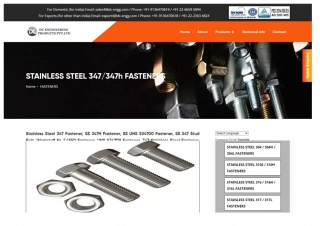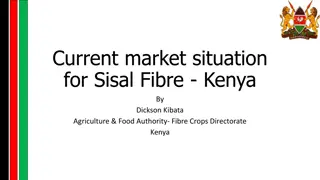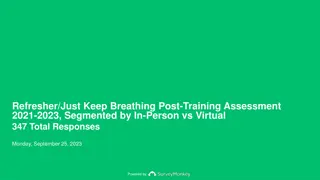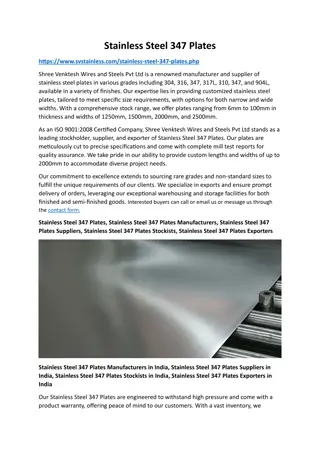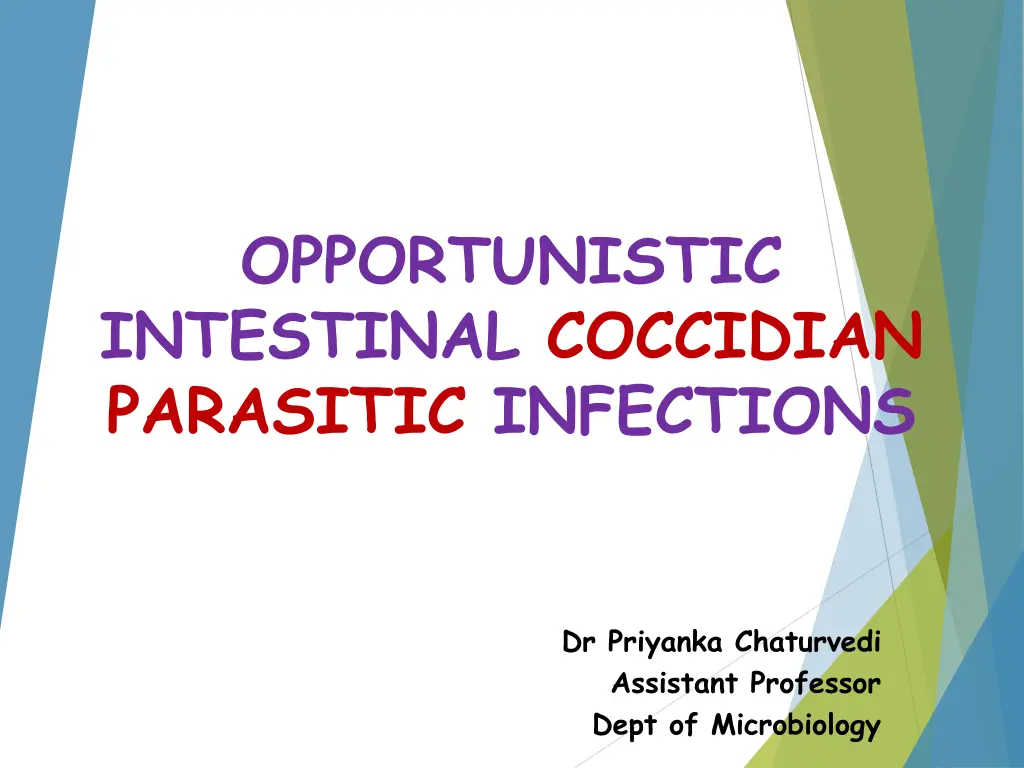
Intestinal Coccidian Parasitic Infections Overview
Learn about opportunistic intestinal coccidian parasitic infections caused by Cryptosporidium, Cyclospora, and Cystoisospora, their morphology, life cycle, epidemiology, and risk factors. Understand the diagnosis and impact on HIV-infected patients.
Download Presentation

Please find below an Image/Link to download the presentation.
The content on the website is provided AS IS for your information and personal use only. It may not be sold, licensed, or shared on other websites without obtaining consent from the author. If you encounter any issues during the download, it is possible that the publisher has removed the file from their server.
You are allowed to download the files provided on this website for personal or commercial use, subject to the condition that they are used lawfully. All files are the property of their respective owners.
The content on the website is provided AS IS for your information and personal use only. It may not be sold, licensed, or shared on other websites without obtaining consent from the author.
E N D
Presentation Transcript
OPPORTUNISTIC INTESTINAL COCCIDIAN PARASITIC INFECTIONS Dr Priyanka Chaturvedi Assistant Professor Dept of Microbiology
OPPORTUNISTIC INTESTINAL COCCIDIAN PARASITIC INFECTIONS Cryptosporidium, Cyclospora, and Cystoisospora are the intestinal coccidian parasites - cause opportunistic infections in HIV infected patients producing profuse watery diarrhea. Diagnosed by detection of acid fast oocysts in stool microscopy
OPPORTUNISTIC INTESTINAL COCCIDIAN PARASITIC INFECTIONS Cryptosporidium species infecting man classified as two separate species, C. parvum (mammals, including humans) and C. hominis (primarily humans).
OPPORTUNISTIC INTESTINAL COCCIDIAN PARASITIC INFECTIONS Cyclospora cayetanensis - recently described coccidian parasite, as human intestinal pathogen. Isospora belli - recently renamed as Cystoisospora belli - only species that infects man.
MORPHOLOGY The life cycle of coccidian parasites passes through various stages - oocyst, trophozoite, schizont (meront), merozoite, and zygote. Oocyst is the infective form to man as well as the diagnostic form excreted in the feces.
SPORULATED OOCYSTS A. Cryptosporidium; B. Cyclospora; C. Cystoisospora.
EPIDEMIOLOGY Seen worldwide - more prevalent in tropical and subtropical climates of developing countries from South America, Africa, and Southeast Asia including India.
EPIDEMIOLOGY (Cont..) Risk factors - More common in area with poor sanitation and HIV infected individuals Peak age: Infants and children are commonly affected Source of infection - rainwater lodges and swimming pool, recreational water, or contaminated food.
PATHOGENESIS Excystation: Oocyst secretes proteases and aminopeptidases - facilitate excystation in small intestine, releasing sporozoites Attachment: Sporozoites attach to the brush border epithelium of the small intestine (ileum) -CP47 (47 kDa Cryptosporidium protein)
PATHOGENESIS (Cont..) Penetration: Discharges from the apicomplex present in the anterior end of the sporozoites help in invasion Vacuole: Parasitophorous vacuole near the microvilli surface of the host cells
PATHOGENESIS (Cont..) Cytokines: Release cytokines like tumor necrosis factor (TNF)- , IL-8, prostaglandins, etc. which induce Inflammation These factors increase intestinal secretion of chloride and water and decrease the sodium absorption leading to fluid loss and diarrhea.
CLINICAL FEATURES Immunocompetent Hosts: Majority of infections - asymptomatic. Some individuals develop symptoms - average incubation period of about 1 week. Watery non-bloody diarrhea - common presentation. Abdominal pain, nausea, anorexia, fever, and/or weight loss may be present Self-limiting - subsides within 1 2 weeks
CLINICAL FEATURES Immunocompromised Hosts (e.g. AIDS): Chronic, persistent profuse diarrhea (1 25 L/day). Severe weight loss, wasting and abdominal pain . Extraintestinal manifestations - biliary tract infection (sclerosing cholangitis), respiratory tract infection, and pancreatitis Disease is more severe in patients with AIDS when CD4+ T cell counts become <100/ L
Direct Microscopy (Stool Examination) Sample collection: Three stool samples should be collected. Rarely (in HIV positive patients), sputum, bronchial wash, duodenal or jejunal aspirate can be collected Direct wet mount: Highly refractile, double-walled oocyst
Direct Microscopy (Stool Examination) Concentration technique: If the oocyst load is less, then various techniques are used to concentrate the stool sample Acid-fast staining: Oocysts are acid-fast to 0.5 1% sulfuric acid or acid alcohol and appear as red color oocysts against blue back ground
Direct Microscopy (Stool Examination) Direct fluorescent antibody staining: Available for cryptosporidiosis - oocysts can be detected by using fluorescent labeled monoclonal antibody directed against cyst wall antigens. Autofluorescence: Oocysts of Cyclospora fluoresce when viewed under ultraviolet epifluorescence microscopy. Phase contrast microscopy
Differences between Cryptosporidium, Cyclospora and Cystoisospora
PROPERTY CRYPTOSPORIDIUM CYCLOSPORA CYSTOISOSPORA Infective form Sporulated oocyst Sporulated oocyst Sporulated oocyst Diagnostic form Sporulated oocyst Unsporulated oocyst Unsporulated oocyst 4 6 mm 8 10 mm 20 33 mm Oocyst size Oocyst shape Round Round Oval Four sporozoites Sporulated oocyst contain Two sporocysts, each having two sporozoites Two sporocysts, each having four sporozoites
Property Cryptosporidium Cyclospora Cystoisospora Acid-fastness Uniformly acid- fast Variable acid- fast Uniformly acid- fast Autofluorescence No, but can be Autofluorescence ++ Autofluorescence +/- stained with fluorescent dye
Cryptosporidium species A.Modified acid-fast stain showing RED COLOURED OOCYSTS
Cryptosporidium species B. Direct fluorescent antibody staining shows BRILLIANT GREEN FLUORESCENT OOCYSTS
Cyclospora species B. Epifluorescence microscopy showing AUTO-FLUORESCENT OOCYSTS
Cyclospora species C. Modified acid-fast stain showing RED COLOURED OOCYSTS
Cystoisospora belli A. Saline mount preparation shows Left UNSPORULATED OOCYST Right SPORULATED OOCYST
Cystoisospora belli B. Modified acid-fast stain showing RED COLOURED OOCYSTS
Cystoisospora belli C. Phase contrast microscopy showing OOCYST
Cystoisospora belli D. Fluorescent stained smears showing OOCYST.
Antigen Detection from Stool ELISA ICT
Antibody Detection ELISA are available detecting antibodies in patient s serum against oocyst antigens of Cryptosporidium or Cyclospora.
Molecular Diagnosis PCR or real-time PCR can be performed to detect specific genes such as 18S rRNA or small subunit rRNA. BioFire FilmArray
Other Methods Low CD4-T lymphocyte count (especially in HIV positive patient) Fecal leukocyte marker lactoferrin is increased in 75% of cases indicating increase pus cells in feces.
Treatment of Intestinal coccidian parasitic infections Mild cases Self-limiting, requires fluid replacement like ORS. Lactose-free preferred for cryptosporidiosis. glutamine supplemented diet is
Treatment of Intestinal coccidian parasitic infections Severe cases Cryptosporidiosis: Nitazoxanide is given to adults Cyclosporiasis Cotrimoxazole (for 7-10 days). and cystoisosporiasis:
Prevention Requires minimizing exposure to infectious oocysts in human or animal feces Proper hand washing, use of submicron water filters, use of appropriate disinfectants/sterilants to kill the oocysts (such as hydrogen peroxide, steam sterilization), improved personal hygiene are some of the efforts to prevent transmission.
1. About Cryptosporidium. All are true except: a. Shape round b. Size (4 6 m) c. Causes cholangitis d. Having two sporozoites
2. True about cryptosporidium are all except: a. Oocyst chorine resistant b. Acid fast oocyst c. Oocyst > 100 micro meters d. Enzyme immune assay done
3. Which of the following is not a coccidian? a. Isospora b. Cyclospora c. Crytosporidia d. Enterocytozoon
4. Cryptosporidium cyst identified by which stain in stool sample? a. PAS b. H and E c. Giemsa d. Acid fast stain
5. 25-years-old male presented with diarrhea for 6 months. On examination the causative agent was found to be acid fast with 12 micro meter diameter. The most likely agent is: a. Cryptosporidium b. Isospora c. Cyclospora d. Giardia

